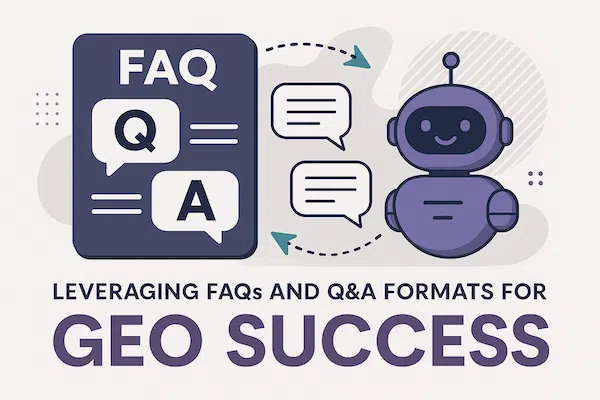Tuesday, August 19, 2025 |
Brief Overview:
This article explores how FAQs and Q&A-based content dramatically improve visibility in AI-generated answers. It provides strategies to write and format Q&A content that aligns with the information retrieval models used by generative search engines.
Why FAQs Matter More Than Ever in the GEO Era
Generative AI thrives on concise, direct answers. As a result, FAQ and Q&A formats are now some of the most highly valued structures for AI summarisation engines.
FAQs provide:
-
Modular content blocks that are easily lifted into generative responses
-
Clear, semantic pairings of question and answer
-
Relevance to long-tail, natural language search queries
-
Enhanced user experience and reduced bounce rates
How Generative AI Selects and Uses FAQ Content
When AI engines generate a response, they often prioritise content that mimics the question-answer format of the user query. Well-written FAQs serve as perfect sources for these engines to quote, paraphrase, or extract.
Examples of use cases:
-
“What is the difference between SEO and GEO?” → Answer pulled from your FAQ
-
“How often should you update your website content?” → Pulled from your blog’s Q&A section
-
“Is video content important for AI search?” → Referenced from a structured article with embedded Q&A
Building the Perfect FAQ for GEO
To maximise your content’s performance in AI-driven environments, use the following structure:
-
Use specific, user-intent-driven questions
❌ Avoid: “What’s SEO?”
✅ Use: “How does SEO impact Google’s AI-generated results?” -
Answer in 2-4 sentences with clarity
-
Start with a direct answer.
-
Follow up with 1-2 sentences of nuance or context.
-
Use simple, active language.
-
-
Add schema markup for FAQs
-
Use
FAQPagestructured data (via Schema.org) to flag your content for crawlers and AI training models.
-
-
Group FAQs by topic
-
Organise pages with headings like “SEO FAQs”, “Branding FAQs”, or “Video Content FAQs” for contextual strength.
-
-
Refresh regularly
-
AI engines favour fresh data. Rotate your FAQs every 6-12 months based on new trends, tools, or questions from clients.
-
Hidden Gem Insight:
Most sites overlook the value of embedding Q&A blocks inside blog posts, not just on dedicated FAQ pages. AI engines interpret these inline Q&A sections as additional authority signals, especially when matched with structured data. This gives your articles double exposure: as blog content and as summarised answers.
Additional Q&A Opportunities That Enhance GEO
-
Client Onboarding Pages: Add FAQs about your services to demonstrate expertise.
-
Service Landing Pages: Address concerns or differentiators directly.
-
Knowledge Hubs: Create a Q&A archive grouped by audience pain points.
Final Thoughts
In the world of generative AI search, Q&A isn’t just a support tool, it’s an optimisation strategy. By integrating structured, well-written FAQs throughout your site, you enhance both your human and AI visibility. The clearer and more intentional your answers, the more likely AI is to elevate your voice into the conversation.
